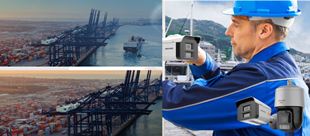Megapixel cameras have become mainstream for larger recording areas and higher resolution footage. Users can define an area of focus, such as an exit, as a virtual camera on the surveillance settings page. And, they can simulate up to four virtual cameras as extended cameras of a physical camera; no additional camera licenses are required, users can view physical cameras and virtual cameras in the same view.
High-resolution cameras (such as 4K) can cover a much larger area than traditional models. QNAP's Surveillance Station 5.1 supports ROI mode on the remote monitoring page. If a user wants to see the original image and multiple regional images from the same camera in one view, a 5 or 7 split view can be selected to define multiple focus areas on the overview image. No additional camera licenses are required.
The Surveillance Station provides flexible options to set up IP camera recording, including smart recording and dual recording. The smart recording function can automatically switch the recording detail to a higher resolution when alarms are triggered. This greatly saves the cost spent on hard drives. The dual recording function can record higher and lower video streams at the same time. Users can select the recordings to playback depending on the network environment. For greater efficiency, the Surveillance Station provides an intuitive playback interface for easier playback control and more dewarping modes.
The Station supports the transcoding capabilities to convert original high-definition recording to a lower-resolution video before transferring it over the internet. Transcoding only works when using single-channel display mode. If connections are always in low-bandwidth then the user can enable the dual recording function with compatible cameras to save both higher and lower recordings for further use.
Used in conjunction with the Surveillance Station local display function, the QNAP NAS can perform monitoring and playback by using an HDMI display to deliver live full HD (1920x1080) video monitoring. With the playback and speed control shuttle bar, the user can fast-forward and rewind the video by dragging the button respectively. QNAP QvPC technology has been designed to provide a straightforward way to reduce the total cost in the SOHO and SMB environment.
With Surveillance Station, users can easily manage and monitor multiple IP cameras on a real-time basis using web browsers, and attain first-hand status of monitored areas. Users can directly manage the configured PTZ and fisheye cameras and flexibly monitor every required area and detail. With default display modes and user-defined views, users can easily and flexibly manage a surveillance system.
In addition, there is a QNAP Dewarp (Qdewarp) Technology feature that is designed for various monitoring applications. QNAP’s Qdewarp is a generic fisheye dewarp technology that works without affecting original recordings. With Qdewarp, if the fisheye camera is on the company's compatability list, users can choose from many dewarping modes in the remote monitoring page for various monitoring applications, and are not limited to vendor-specific dewarping modes.
The Surveillance Station offers an innovative desktop design to compliment smooth working efficiency. The multi-window design allows concurrent multi-tasking, and enables administrators to easily switch between tasks to increase productivity. The Surveillance Station also provides user-friendly options for users to easily set up their own surveillance system.
















